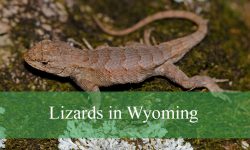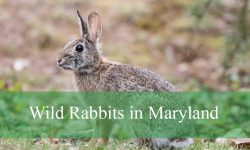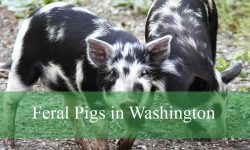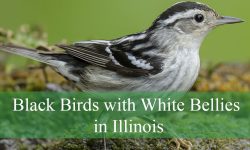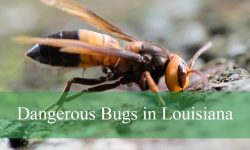Finches are some of Colorado’s most charming and colorful birds. Their vibrant plumage and cheerful songs brighten gardens, parks, and natural areas throughout the state. Watching these lively little birds flit among branches or visit backyard feeders is a joy that many bird lovers treasure.
From the foothills up to the high Rockies, Colorado is home to a diverse range of finch species, each with unique colors and behaviors. In this guide, you’ll discover 18 finch species found in Colorado, along with photos and tips to help you identify them wherever you encounter them.
Common Finches You Can See in Colorado
House Finch (Haemorhous mexicanus)
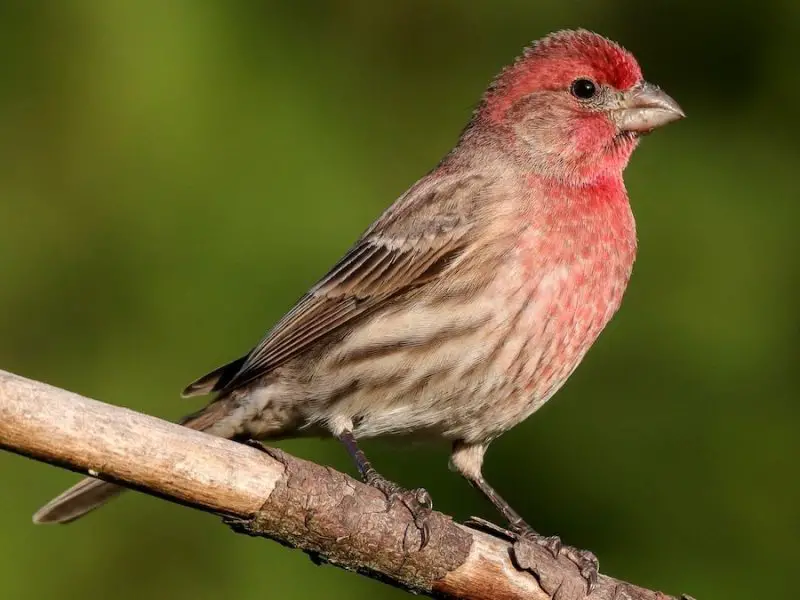
The House Finch is one of the most common and recognizable finches in Colorado. Males are known for their bright red heads, throats, and chests, which contrast with their brown-streaked backs and bellies. Females lack the red coloring and instead display plain grayish-brown plumage with heavy streaks. These small songbirds measure about 5 to 6 inches long, with a wingspan of 8 to 10 inches, and have a slightly curved beak adapted for seed-cracking.
In Colorado, House Finches are year-round residents and are especially common in urban and suburban areas. You can frequently spot them at backyard feeders, especially those offering sunflower seeds. They’re also found in parks, orchards, desert scrub, and open woodlands. Their song is a cheerful warbling series of notes, often delivered from high perches like telephone wires or treetops.
House Finches primarily feed on seeds, grains, and berries, and will occasionally consume flower buds and insects. In cities and residential areas, they’re highly adaptable and not afraid of human presence, often nesting on building ledges or in hanging planters. Their social behavior includes forming small flocks and often feeding together in groups.
Fun Fact: House Finches were originally native to the western U.S. but were introduced to the East Coast in the 1940s when pet shop owners released them in New York. From there, they rapidly spread and are now found across nearly all of the United States.
American Goldfinch (Spinus tristis)
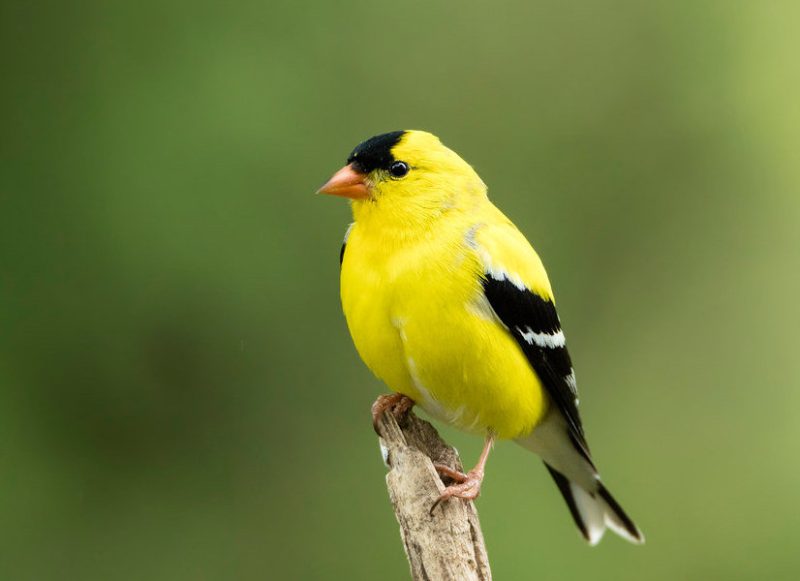
The American Goldfinch is a small, vibrant bird that’s easily identified during the breeding season by the male’s bright yellow body, black cap, wings, and tail. Females and non-breeding males are more subdued, sporting olive-brown or dull yellow tones. Measuring just 4.3 to 5 inches in length and weighing under half an ounce, these finches have short conical beaks perfect for seed eating.
In Colorado, American Goldfinches are commonly seen during the warmer months, especially in open fields, meadows, and weedy areas with thistle and sunflowers. They’re also frequent visitors to backyard feeders offering nyjer (thistle) seed. During winter, their plumage molts into a drab olive-brown, helping them blend into the landscape.
Their diet consists almost exclusively of seeds, including dandelions, asters, and thistles. Unlike many other finches, they breed later in the season—often in late summer—to coincide with peak seed availability. Their bouncing flight pattern and soft, musical calls, such as their “po-ta-to-chip” flight call, make them delightful to observe in flight.
Fun Fact: American Goldfinches are one of the few songbirds that are strict vegetarians. Even when feeding their chicks, they provide regurgitated seeds instead of insects.
Pine Siskin (Spinus pinus)

Pine Siskins are small, streaky brown finches with hints of yellow on their wings and tails. Their slender, pointed bills and notched tails help distinguish them from similar-streaked birds like sparrows. Measuring about 4.3 to 5.5 inches long, Pine Siskins often appear scruffy or slim, but they are highly energetic and active foragers.
In Colorado, these birds are most commonly observed in winter, though they may be seen year-round at higher elevations. They favor coniferous forests, woodland edges, and backyard feeders stocked with nyjer or sunflower seeds. Their populations can fluctuate dramatically from year to year due to irruptions—mass movements driven by food availability up north.
Pine Siskins are acrobatic and social, often feeding in flocks and hanging upside down to reach seeds. Their diet includes seeds from conifers, weeds, and flowers, along with some insects during the breeding season. Their high-pitched, chattering calls are a distinctive soundtrack in mountain habitats.
Fun Fact: Pine Siskins have an extraordinary ability to survive cold weather. They can increase their metabolic rate up to five times their normal rate to generate enough body heat during freezing nights.
Lesser Goldfinch (Spinus psaltria)
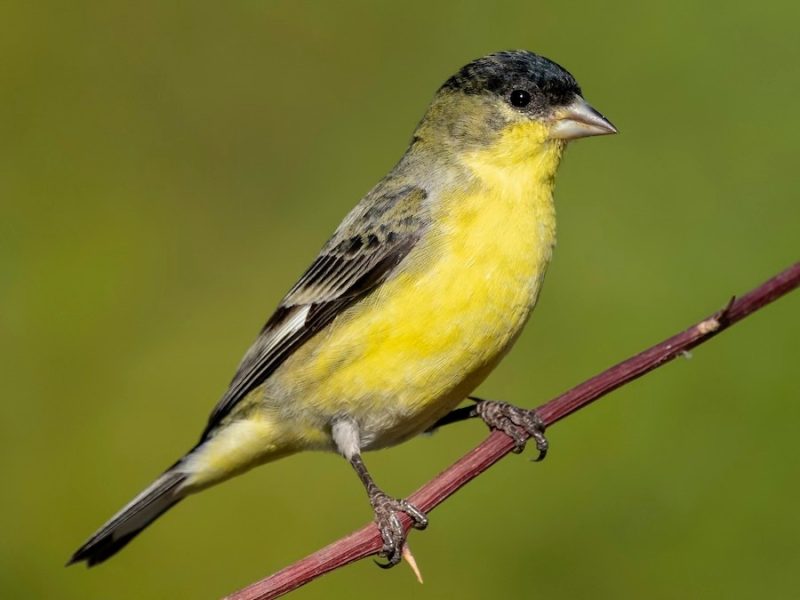
The Lesser Goldfinch is a petite and charming bird found across the western United States, including parts of Colorado during the summer months. Males are striking with their black caps, backs, and bright yellow underparts. In some regions, they show a glossy black back, while others have more olive coloration. Females and juveniles are more subdued with olive-gray tones and less distinct markings.
These birds measure just 3.5 to 4.7 inches in length, making them one of the smallest finch species in North America. In Colorado, they are commonly seen in foothill scrublands, open woodlands, and residential gardens with flowering plants. They’re especially fond of sunflower patches and can be spotted in mixed flocks with other finch species.
Lesser Goldfinches feed on seeds, especially sunflower, dandelion, and thistle seeds. They’re also known to nibble on flower petals and small fruits. Their musical, rapid warbles are a mix of notes that mimic other birds, making their song surprisingly complex for such a small bird.
Fun Fact: Lesser Goldfinches often form large communal roosts, sometimes with hundreds of individuals gathering in a single tree during the non-breeding season.
Cassin’s Finch (Haemorhous cassinii)
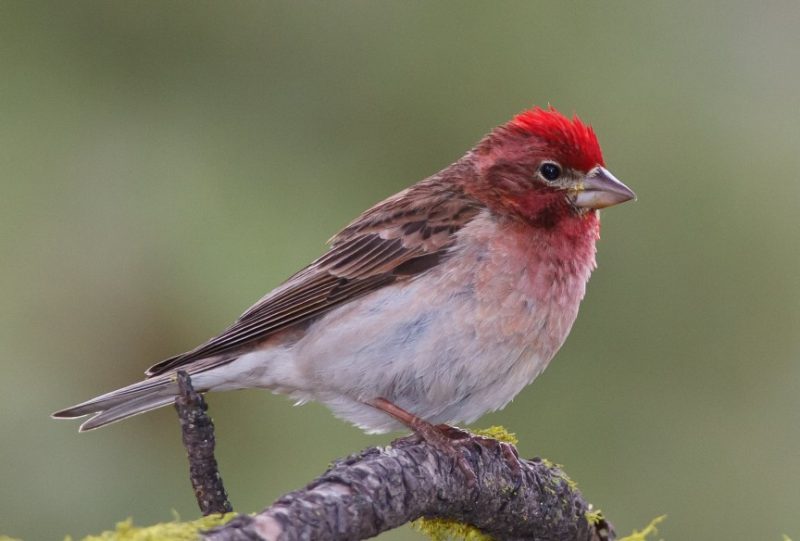
Cassin’s Finch is a medium-sized, chunky finch with a square-tipped tail and a straight, strong bill. Males have a bright red crown, pale pinkish-red face and breast, and streaked flanks, while females and immature birds are brown and heavily streaked overall. They can be confused with Purple Finches but tend to have longer tails and a more peaked crown.
In Colorado, Cassin’s Finches are mostly found in high-elevation coniferous forests, especially during the breeding season. They are more commonly observed in the Rocky Mountains, and in winter, some may move to lower elevations in search of food, even visiting feeders in mountain towns.
Their diet includes seeds, buds, and berries, particularly from conifers like spruce and fir. They also consume insects and flower parts when available. Cassin’s Finches often forage in small flocks and may associate with crossbills or grosbeaks, especially in the winter months.
Fun Fact: The male Cassin’s Finch sings a long, sweet song that includes mimicry of other birds and can be heard echoing through mountain forests in spring and early summer.
Purple Finch (Haemorhous purpureus)
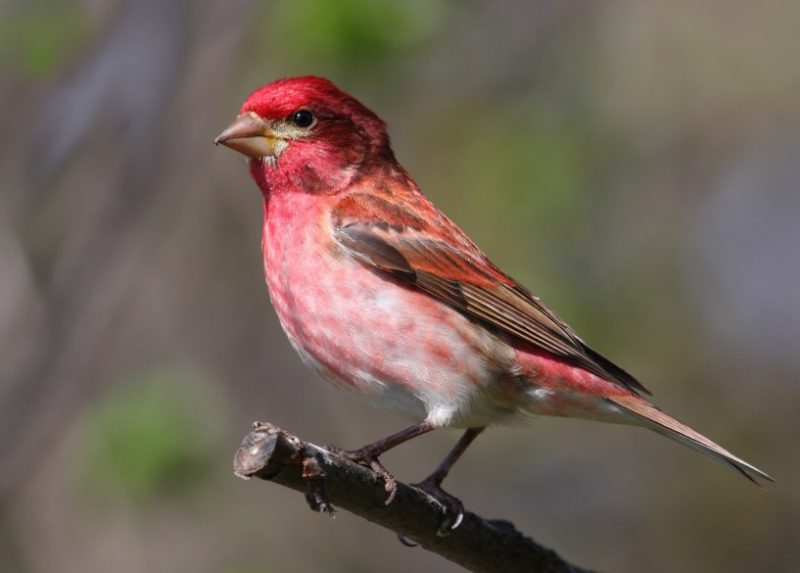
The Purple Finch is a beautiful and somewhat elusive finch species in Colorado. Males are covered in raspberry-red coloring that appears to be dipped across their heads, chests, and backs, while females are brown with bold facial markings and streaked underparts. They measure about 5 to 6 inches in length and have a sturdy, conical beak well-suited for cracking seeds.
Although not a common breeder in Colorado, Purple Finches may be seen during migration or in winter, especially in forested foothills and mixed woodlands. Their preferred habitats include coniferous and deciduous forests, as well as backyard feeders in rural areas. Spotting them requires a bit of luck, especially since they are often confused with House Finches.
Their diet includes seeds, berries, and tree buds, particularly from ash, elm, and fruiting trees. They also consume insects during the breeding season. Purple Finches forage in trees or on the ground and are more likely to visit feeders in colder months. Their song is a rich, warbling series of notes that sounds more fluid and melodic than their relatives.
Fun Fact: John James Audubon once described the Purple Finch as “the bird with the crimson coat,” admiring its coloration long before bird feeders became a tool for attracting them.
Common Redpoll (Acanthis flammea)
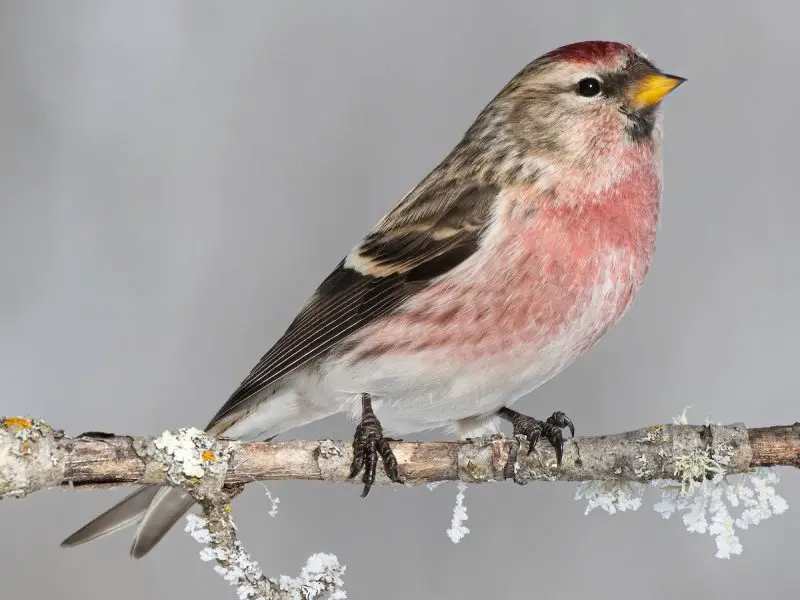
Common Redpolls are tiny finches adapted to cold climates, with a distinctive red cap, black chin, and streaky brown bodies. Males may also have a rosy wash on their chest. These birds measure about 4.5 to 5.5 inches in length and have a small, pointed yellow beak that’s perfect for extracting seeds from catkins and weed heads.
In Colorado, Common Redpolls are considered winter visitors and are not guaranteed to appear every year. They tend to arrive during irruptive years, driven south by food shortages in the Arctic. When present, they’re found in weedy fields, shrubby areas, or at feeders stocked with nyjer or sunflower seeds.
These birds feed primarily on seeds from birch, alder, and willow trees, along with grasses and weeds. They also eat insects when available. Redpolls are extremely cold-hardy and can survive temperatures as low as -60°F. They often travel in large, noisy flocks, and may visit backyard feeders during frigid weather.
Fun Fact: To stay warm, Common Redpolls can dig tunnels in the snow more than a foot deep and sleep there overnight, protected from the wind and cold.
Red Crossbill (Loxia curvirostra)
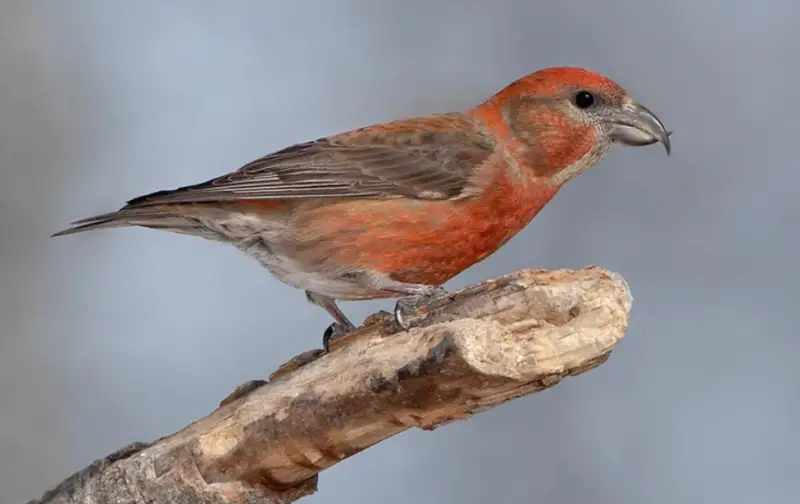
Red Crossbills are unique finches with a specialized bill that crosses at the tip—an adaptation that allows them to pry open conifer cones to extract seeds. Males are typically red or brick-orange, while females are more yellowish or olive. They measure about 6 to 6.5 inches in length and have a stocky build with a short, notched tail.
In Colorado, Red Crossbills are found year-round in coniferous forests, especially in the mountains where spruce, fir, and pine are abundant. Their distribution can be patchy and nomadic, depending on cone crop availability. They’re often detected by their sharp “jip-jip” call notes and fast, direct flight patterns.
Their diet consists almost entirely of conifer seeds, particularly from lodgepole pine, Douglas fir, and spruce. They may forage in flocks, often high in treetops. Crossbills sometimes come down to the ground or birdbaths for grit and water. Their breeding season is flexible and can occur any time of year if food is plentiful.
Fun Fact: Red Crossbills have multiple call types, which some scientists believe may represent distinct, cryptic species, each specializing in different conifer types.
Pine Grosbeak (Pinicola enucleator)
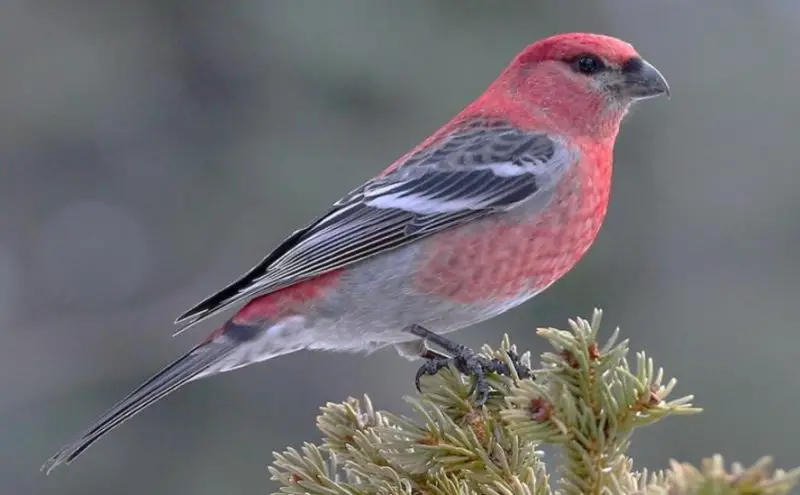
The Pine Grosbeak is a large, gentle finch with a chunky body and thick, curved beak. Males have a soft red wash over their head, chest, and back with gray wings and tail, while females are yellow-orange and gray. They reach up to 8 to 10 inches in length, making them one of the largest finch species in North America.
In Colorado, Pine Grosbeaks are usually found in high-altitude coniferous forests, especially during the winter months. They prefer spruce-fir woodlands and are often seen moving slowly through trees or along snowy roadsides. Unlike many finches, they are tame and less wary of humans, making them easier to observe.
Their diet includes seeds, berries, buds, and insects. During winter, they feed heavily on mountain ash berries and the buds of conifers. Pine Grosbeaks often travel in small flocks and have a quiet, sweet whistling song. Their deliberate movements and low-pitched calls contrast sharply with the more energetic behavior of smaller finches.
Fun Fact: Because of their calm and sluggish nature, early explorers nicknamed Pine Grosbeaks the “moose birds,” due to their quiet, lumbering presence in the forest.
Evening Grosbeak (Coccothraustes vespertinus)

Evening Grosbeaks are striking finches with thick, powerful bills and bold coloration. Males are golden yellow with a black head and back, white patches on their wings, and bright yellow eyebrows. Females are grayish with white wing patches and subtle yellow highlights. These birds are large for finches, measuring about 6.5 to 8.5 inches long.
In Colorado, Evening Grosbeaks are seen more often in the winter and are considered irruptive, meaning they appear in variable numbers depending on food sources. They are found in mountain forests, residential areas, and feeders offering sunflower seeds. Their presence is unpredictable but exciting for birders.
They feed on seeds, fruits, buds, and insects. Thanks to their powerful beaks, Evening Grosbeaks can crack open even the toughest seeds. During outbreaks of spruce budworm, they consume large quantities of caterpillars, helping control forest pests. They often arrive at feeders in noisy flocks and can empty a tray of seeds in no time.
Fun Fact: Despite their name, Evening Grosbeaks are active throughout the day—not just in the evening. The name originated from a mistaken belief by early naturalists who observed them flying at dusk.
Gray-crowned Rosy-Finch (Leucosticte tephrocotis)

The Gray-crowned Rosy-Finch is a hardy bird of the high mountains, easily recognized by its chocolate-brown body, rosy-pink highlights on the belly and wings, and a gray patch on the crown of the head. These medium-sized finches measure around 5.5 to 6.3 inches in length and have a slender body with a short, slightly notched tail.
In Colorado, Gray-crowned Rosy-Finches breed in alpine tundra above the tree line and descend to lower elevations during winter. They are most often seen in winter months around rocky slopes, canyons, and even at feeders in mountain towns. Their plumage provides perfect camouflage against snowy and rocky terrain.
Their diet consists mainly of seeds from grasses and weeds, as well as small insects during the summer. They forage in flocks, often in windblown areas where snow is sparse. During severe cold, they will roost in rock crevices or buildings, and sometimes enter structures to find warmth and food.
Fun Fact: Gray-crowned Rosy-Finches have been recorded nesting on cliffs right next to glaciers and snowfields—among the highest elevation nesting birds in North America.
Black Rosy-Finch (Leucosticte atrata)
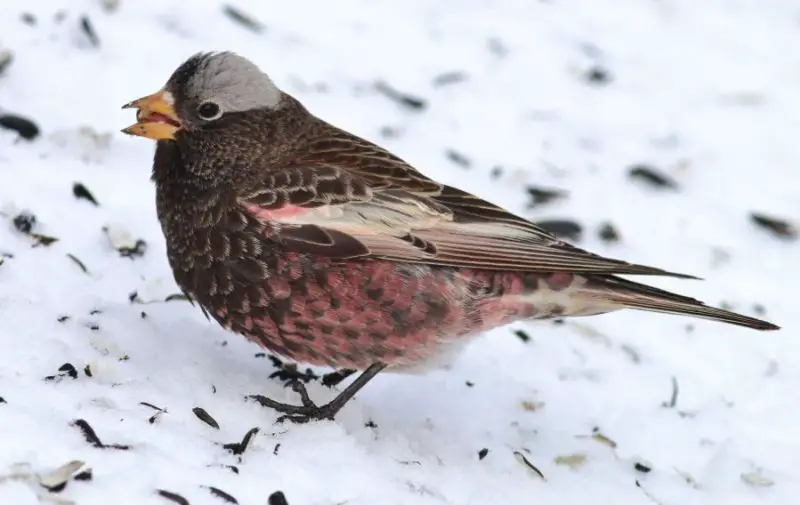
The Black Rosy-Finch is one of the rarest finches to spot in Colorado, with a deep brownish-black body, subtle pinkish tones on the wings and belly, and a gray patch on the back of the head. Slightly stockier than its relatives, it measures about 5.5 to 6.3 inches in length and is specially adapted for life in harsh alpine environments.
In Colorado, Black Rosy-Finches are mostly winter visitors to high-altitude regions, though they sometimes descend to lower elevations during storms or harsh cold. They frequent windswept slopes, cliffs, and snowy meadows, where they forage in mixed flocks with other rosy-finches.
Their diet includes weed seeds, grass seeds, and small insects. During the breeding season, they nest in inaccessible rocky cliffs, making observations of their nests quite rare. They are ground foragers and often probe the snow with their bills to find food hidden beneath.
Fun Fact: This species may endure some of the coldest, windiest breeding conditions of any songbird in North America—sometimes nesting at elevations over 13,000 feet.
Brown-capped Rosy-Finch (Leucosticte australis)
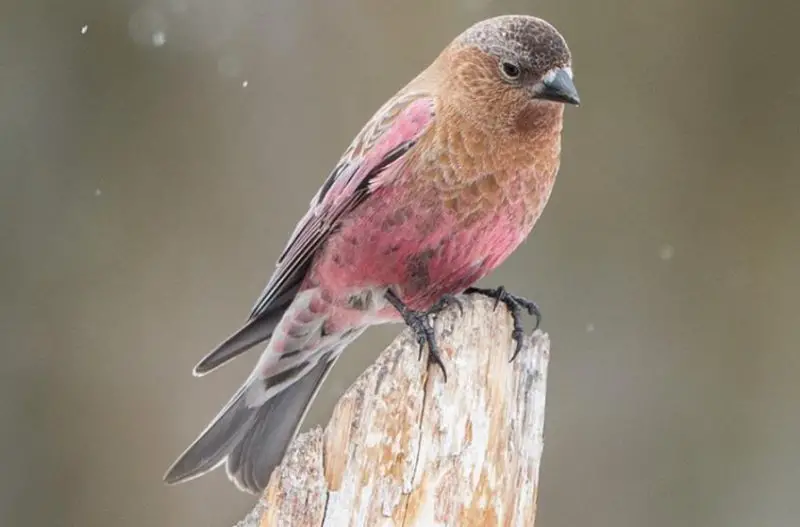
Endemic to the Rocky Mountains, the Brown-capped Rosy-Finch is found almost exclusively in Colorado and northern New Mexico. It has a brown crown (unlike the gray crown of other rosy-finches), a dusty brown body, and rich rosy hues on the belly and wings. It reaches about 5.5 to 6.3 inches in length and has a thick, conical bill.
In Colorado, this species nests at extremely high elevations—often near snowfields and rocky cliffs above the tree line. In winter, Brown-capped Rosy-Finches descend into subalpine valleys, ski areas, and mountain towns, where they may visit feeders stocked with sunflower seeds or millet.
Their feeding habits are similar to those of other rosy-finches: they forage for weed seeds, grass seeds, and the occasional insect. They often appear in mixed flocks with the other two rosy-finch species and can be challenging to tell apart without close observation.
Fun Fact: The Brown-capped Rosy-Finch is considered the most range-restricted of the three rosy-finch species and is a conservation concern due to its limited habitat.
Blue Grosbeak (Passerina caerulea)
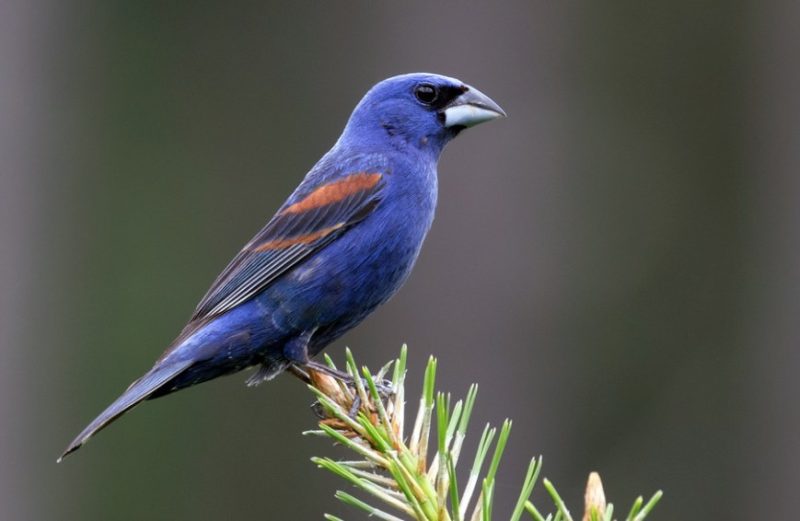
The Blue Grosbeak is a stunning and secretive finch-like bird with rich blue plumage and two rusty wing bars. Females are more subdued in color, appearing light brown with hints of blue on the wings and tail. These medium-sized birds measure about 5.5 to 7.5 inches long and have stout, thick beaks designed for seed cracking.
In Colorado, Blue Grosbeaks are summer visitors and are found mainly in brushy areas, open woodlands, riparian zones, and agricultural edges. They are more common in the eastern and southern parts of the state and often go unnoticed due to their elusive behavior.
Their diet includes seeds, grains, and insects, particularly during the breeding season. Males often sing from prominent perches, delivering a rich, warbled song that helps mark their territory. Though shy and solitary, they may sometimes visit feeders in rural areas with dense shrubbery nearby.
Fun Fact: Blue Grosbeaks are part of the cardinal family (Cardinalidae) but are often grouped with finches due to similar size and habits.
Black-headed Grosbeak (Pheucticus melanocephalus)
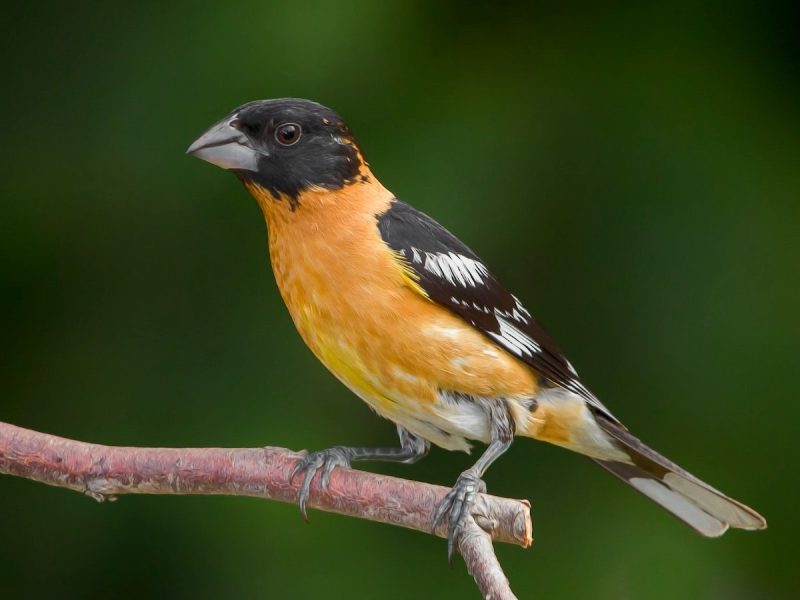
The Black-headed Grosbeak is a striking songbird with a bold appearance. Males have black heads, wings, and backs with orange-brown breasts and white wing patches, while females display a streaky brown pattern with buffy underparts. These birds are about 7 to 8 inches long and have a powerful beak perfect for breaking hard seeds and crushing beetles.
In Colorado, Black-headed Grosbeaks are summer breeders, especially in riparian woodlands, canyon bottoms, and deciduous forests. They are most commonly seen west of the plains and into the foothills, where dense vegetation offers both food and nesting cover.
Their diet includes seeds, fruits, berries, and insects, and they are known to feed on monarch butterflies, which are toxic to most birds. They use their thick bills to crush the butterfly and avoid the toxic parts. Their song resembles that of an American Robin but is more fluid and musical, often heard throughout the day during summer.
Fun Fact: Black-headed Grosbeaks are one of the few birds that can safely eat monarch butterflies, thanks to their ability to tolerate the cardiac glycosides stored in the butterfly’s body.
Lawrence’s Goldfinch (Spinus lawrencei)
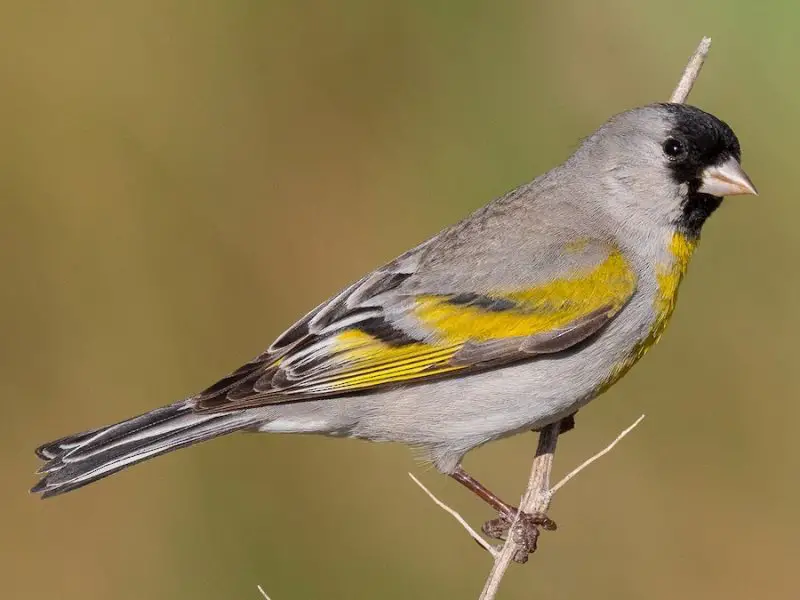
Lawrence’s Goldfinch (Spinus lawrencei) is a small, eye-catching finch with distinctive plumage. Males are pale gray with bright yellow breast patches, black facial markings, and yellow wing bars. Females are more subdued but still retain hints of yellow and soft gray. These birds measure about 4.75 inches long with a wingspan of 8 inches.
They are a rare visitor in Colorado and more commonly found in the southwestern United States. Occasionally, they appear in southern parts of the state during late summer or early fall. They prefer dry, open habitats such as oak woodlands and chaparral but can be attracted to feeders with nyjer seed during irruption years.
Lawrence’s Goldfinches are seed specialists, especially fond of fiddleneck, chamise, and other weedy plants. They often feed in small flocks and can be seen performing fluttery flights as they move between perches or feeding areas.
A unique trait of this species is that it does not breed on a strict seasonal schedule like most birds. Instead, its breeding is closely tied to rainfall and food availability, making it one of the few finches with such flexibility.
Hoary Redpoll (Acanthis hornemanni)
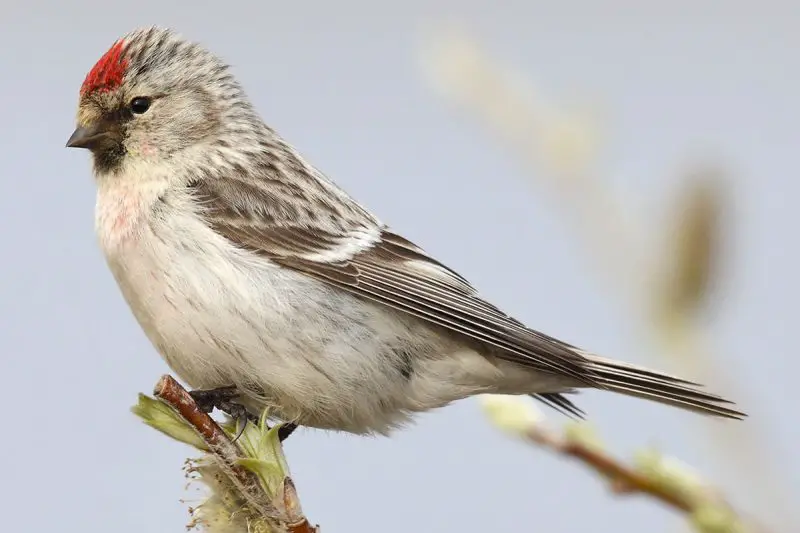
The Hoary Redpoll is one of the smallest and rarest finches found in Colorado, especially during irruption years when birds migrate south from the Arctic. It closely resembles the Common Redpoll but has much paler plumage—almost frosty white—with fine brown streaks and a distinctive red patch on its forehead. Males may show a light pinkish wash on the chest, while females are typically pale gray with fewer streaks.
This species is occasionally spotted in winter, especially in dry grasslands, forest edges, or at feeders offering nyjer and sunflower seeds. However, its presence in Colorado is unpredictable and typically only occurs during years when Arctic food supplies are low, forcing them to move farther south in search of food.
Hoary Redpolls primarily feed on seeds from birch, willow, and various weedy plants, but they will also eat small insects during the breeding season. These birds are incredibly cold-hardy and have been observed burrowing into snowbanks to stay insulated through freezing nights.
Fun Fact: The Hoary Redpoll is one of the smallest birds capable of living year-round in the high Arctic, where temperatures can drop below -70°F.
FAQs about Finches in Colorado
What is the most common finch in Colorado?
The most common finch in Colorado is the House Finch. These adaptable birds are frequently seen in cities, suburbs, and backyards throughout the state. They’re recognizable by the male’s red head and breast and the female’s brown streaking.
Do finches stay in Colorado year-round?
Yes, several species like the House Finch, Cassin’s Finch, and American Goldfinch stay in Colorado year-round. However, some species such as the Common Redpoll and Pine Grosbeak are more likely to appear only during the winter months or in specific habitats like high-elevation forests.
What do finches eat in Colorado?
Finches in Colorado primarily eat seeds, especially sunflower, thistle (nyjer), and conifer seeds. Some, like Pine Siskins, also consume insects and tree buds. At feeders, they are especially fond of nyjer and black oil sunflower seeds.
How can I attract finches to my yard in Colorado?
To attract finches, use feeders stocked with nyjer seed, black oil sunflower, or hulled sunflower chips. Plant native seed-bearing plants like coneflowers, thistles, and sunflowers. Providing fresh water in a birdbath also helps, especially in dry seasons.
Are goldfinches and yellow finches the same in Colorado?
Yes, the term “yellow finch” often refers to the American Goldfinch, which is the bright yellow species found in Colorado. Males are vivid yellow with black caps during the breeding season, while females are duller yellow-brown.
Are finches native to Colorado?
Yes, many finch species are native to Colorado, including Cassin’s Finch, American Goldfinch, Pine Siskin, and House Finch. Some species, like the Common Redpoll, are seasonal or appear during specific years depending on food availability.
What time of year is best to see finches in Colorado?
Spring and summer are great for spotting breeding finches in Colorado’s foothills and mountains. Winter brings in irruptive species like the Common Redpoll and Pine Grosbeak to lower elevations, making year-round birdwatching rewarding.

